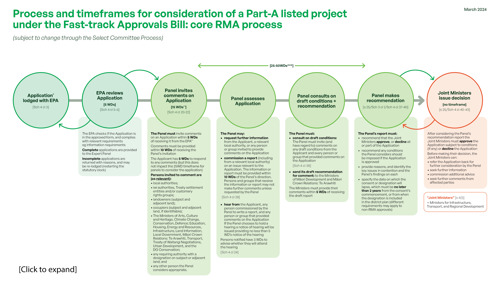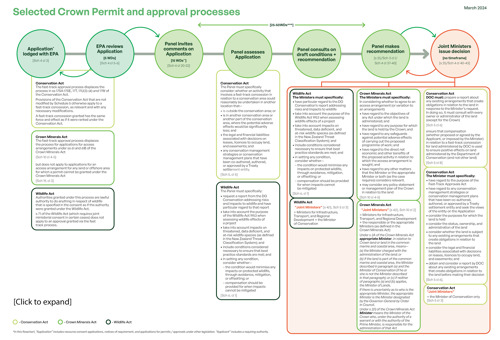11/04/2024
The Fast-track Approvals Bill: suggestions to enhance ‘one-stop’ shop

Much has been written about the Fast-track Approvals Bill since it was released a few weeks ago and much of the commentary has focused on resource consents and the intended “Fast Track” elements of the Bill.
This update puts the focus on the “one-stop” shop process created by the Bill, which is intended to lead to better coordination and timely decisions for various Crown permits and approvals (alongside the RMA processes).
Need for “one-stop” shop
Ministers have been clear that they intend this Bill to pull together a number of related Crown permits, approvals and consents into a “one-stop” shop, with the Expert Panel considering applications together, and then creating a common set of conditions across all permits and approvals that the project requires.
This is a positive development and one used in a number of overseas jurisdictions.
We see clients that struggle with opaque Government decision-making processes, where the timeframes are unclear and can be extended. In addition to resource consents, large projects currently need multiple Crown approvals across different departments, with limited coordination between officials and often overlapping (and sometimes contradictory) conditions imposed by those departments. The administrative burden of these permits is made worse where officials grant short permit periods, requiring almost constant refreshment (in one instance, a department took a year to make a decision to grant an extension, and then only issued it for a year).
Given the current challenges with government decision-making, the power and efficiency gains of the “one-stop” shop should not be overlooked - it has real potential to improve timely government decision-making for large projects. This model will also be a much more public process for seeking these Crown approvals. Currently, many of these applications are currently made directly to officials, with limited or no public notification.
In this article, we’ve identified areas of potential improvement for the Bill, to ensure that this process reaches its best potential to deliver an effective “one-stop” shop.
Remember: Select committee submissions close on 19 April 2024. We encourage everyone with an interest in the Bill to make a submission.
The current process: at a glance
The Bill is intended to create a “one-stop” shop for obtaining approvals under various legislation, using a single process and resulting in a single co ordinated set of conditions.
The Bill is arranged in three parts.
- The main text of the Bill provides the "top and tail" skeleton process for applications to be referred to an Expert Panel for consideration, and for the Panel to then create a common set of conditions for the permits and approvals. Joint ministers then consider and decide on the panels’ recommendations at the end of the process.
More specific processes and the considerations relevant to each approval type are found in the Bill’s many Schedules. - Schedule 4 contains the process for approvals sought under the Resource Management Act 1991. It is by far the most developed process. This is unsurprising. The Bill was prepared at speed, and a precedent for fast-track resource consenting was available in the former COVID-19 Recovery (Fast-track Consenting) and Natural and Built Environment Acts. This process appears to have been broadly imported into the Bill, forming the "core" framework for the Expert Panel process.
We have prepared a flow chart which outlines the steps after an RMA project is listed in Schedule 2A or is referred through Order in Council [click image to enlarge]:
- Considerations and process steps for other approvals, permits and consents are included in other specialised Schedules, relative to the Conservation Act 1987, Reserves Act 1977, Wildlife Act 1953, Heritage New Zealand Pouhere Taonga Act 2014, Freshwater Fisheries Regulations 1983, Exclusive Economic Zone and Continental Shelf (Environmental Effects) Act 2012, Crown Minerals Act 1991, and Fisheries Act 1996.
These schedules are noticeably less developed than the drafting in Schedule 4. They are not well integrated into the ‘core process’ and in a number of instances, key information is provided late in the process and to Ministers for the final stage of decision making.
This is clear from the flow chart we have prepared in relation to a number of the other Schedules [click image to enlarge]:
Room for improvements to “one-stop”
We have set out some of our thoughts on how the process could be improved and strengthened.
Integrating approval processes
There is currently a lack of integration between the three parts of the Bill: the main text, Schedule 4, and other permitting/approval Schedules. In order to deliver effectively, integration is essential. It will be a game changer to have a common application and for the expert panel to consider all the approvals made under the regime.
To support this, the full suite of information relevant for any particular application should be provided to the Expert Panel early in its process, to inform its recommendation to the Ministers. At present, some reports and input from Ministries are provided to Ministers at the end of the process. This information should be provided to the Expert Panel at the beginning; introducing new information to the Ministers at the end of the process is both inefficient and creates unnecessary risks.
Common conditions and timeframes
The Bill refers to the Expert Panel considering and recommending ‘conditions”. We support this, and suggest stronger direction that the Panel be required to propose a single set of conditions across all the consents, approvals and conditions required for the project. This single set would enable the Expert Panel to consider and address all the relevant requirements and effects of the project, for mitigations and off-sets to act consistently across the project and for co-ordinated timeframes to be created.
A lack of coordination across approvals is currently one of the most challenging elements for large projects, which need to seek permits and approvals from different parts of the government - the approvals are granted but, without consistent, coordinated and coherent conditions, they can at times work against each other.
This can lead to absurd outcomes: a single population of snails may have four or five different Crown permits that in some way relate to them, each requiring different steps to be taken, with different mitigations and/or off-sets, and with duplicated and overlapping monitoring and reporting requirements.
Timeframes
The Bill imposes strict timeframes on the EPA’s review of applications, the provision of written comments, and on panels’ deliberations. These timeframes are very tight and risk being unworkable, particularly given the scale of regionally or nationally significant projects. Tight timeframes for Expert Panels might also have the effect of discouraging the best people from sitting on panels, which again could risk the effectiveness of regime.
In our view, a robust “one stop” process is more important than the speed of the “fast track” element. Given the likely size and significance of these projects, taking a bit more time to enable more input from key stakeholders and better refinement of conditions is likely to lead to a better overall outcome. Accordingly, we recommend that the approval process should be amended to provide more realistic timeframes for decision-makers, to allow them to meaningfully engage with the likely significant volumes of material and expert evidence.
Conversely, there are steps in the process (Ministry advice and Ministerial decisions) for which no timeframes are prescribed. This could lead to delays and bottlenecks. We recommend that timeframes are introduced to this part of the process.
There are also three rounds of mandatory consultation for a referred project. This is more than is currently required for an RMA project or for any of the Crown permits being included in the Bill. There may be an opportunity to rationalise mandatory consultation. Removing a mandatory consultation step would not prevent an applicant from undertaking targeted consultation, as they often do under the current processes.
Decision making tools
We recommend that the Expert Panels are able to utilise mediation, expert conferencing, and a form of hearings. During the Covid-19 Fast Track processes, matters often took longer because the parties weren’t able to be “in the room”, talking to each other and looking to understand the issues raised.
As we read the Bill, it appears that the Expert Panel’s functions are intended to be closer to an inquiry than a traditional contested hearing. We support this. A more inquisitorial process, perhaps using workshops on specific topics could help Expert Panels resolve or narrow the issues in a cost and time effective manner. Our experience working with the Environment Court and its approach to alternative dispute resolution demonstrate that this can promptly focus on the key issues in contention.
Want to have your say?
Please contact one of our experts below if you would like assistance with making a submission to the Select Committee.
Special thanks to Jade Magrath for her assistance writing this article.











